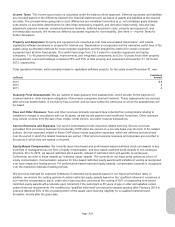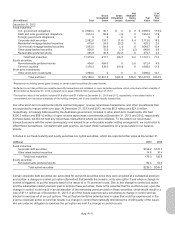Progressive 2013 Annual Report Download - page 19
Download and view the complete annual report
Please find page 19 of the 2013 Progressive annual report below. You can navigate through the pages in the report by either clicking on the pages listed below, or by using the keyword search tool below to find specific information within the annual report.
During 2011, we issued $500 million of 3.75% Senior Notes due 2021 (the “3.75% Senior Notes”) and entered into a
forecasted debt issuance hedge (cash flow hedge) against a possible rise in interest rates (see Note 4 – Debt for further
information). Upon issuance of the 3.75% Senior Notes in August 2011, the hedge was closed and we recognized, as part
of accumulated other comprehensive income, a pretax unrealized loss of $5.1 million. The $5.1 million loss was deferred
and is being recognized as an increase to interest expense over the life of the 3.75% Senior Notes.
During both 2013 and 2012, we recognized $2.1 million as a net decrease to interest expense on these closed debt
issuance cash flow hedges, compared to $2.6 million during 2011.
INTEREST RATE SWAPS
At December 31, 2013, 2012, and 2011, we invested in interest rate swap positions primarily to manage the fixed-income
portfolio duration. During 2013, we opened three 10-year interest rate swap positions with a total notional value of
$750 million. In each case, we are paying a fixed rate and receiving a variable rate, effectively shortening the duration of our
fixed-income portfolio. As of December 31, 2013, we recognized a fair value gain of $68.1 million, on the balance sheet,
reflecting rising interest rates since the positions were opened.
During 2013, we closed three interest rate swap positions with a total notional value of $1,263 million. The closed positions
included a 9-year interest rate swap position (opened in 2009 and partially closed in 2011) and two 5-year interest rate
swap positions (opened in 2011); in each case, we were paying a fixed rate and receiving a variable rate, effectively
shortening the duration of our fixed-income portfolio. We recognized a fair value loss of $95.5 million on the closed positions
as of December 31, 2012, which resulted from an overall decline in interest rates from the inception of the trades.
As of December 31, 2013, the balance of the cash collateral that we had received from the applicable counterparty on these
positions was $62.7 million. As of December 31, 2012 and 2011, the balance of the cash collateral that we had delivered to
the applicable counterparty on these positions was $105.0 million and $81.7 million, respectively.
CORPORATE CREDIT DEFAULT SWAPS
Financial Services Sector – We held no credit default swaps in this sector during 2013. During 2012, we closed one position
that was opened during 2008, on a corporate issuer within the financial services sector for which we bought credit default
protection in the form of a credit default swap for a 5-year time horizon. We held this protection to reduce some of our
exposure to additional valuation declines on a preferred stock position of the same issuer. As of December 31, 2011, the
balance of the cash collateral that we had received from the counterparty on the then open position was $0.7 million.
Automotive Sector – We held no credit default swaps in this sector during 2013 or 2012. During 2011, we closed one
position where we sold credit protection in the form of a corporate credit default swap on one issuer in the automotive sector
for a 5-year time horizon; the position was opened during 2010. We would have been required to cover a $10 million
notional value if a credit event had been triggered, including failure to pay or bankruptcy by the issuer. We acquired an
equal par value amount of U.S. Treasury Notes with a similar maturity to cover the credit default swap’s notional exposure.
3. FAIR VALUE
We have categorized our financial instruments, based on the degree of subjectivity inherent in the method by which they are
valued, into a fair value hierarchy of three levels, as follows:
•Level 1: Inputs are unadjusted, quoted prices in active markets for identical instruments at the measurement date
(e.g., U.S. government obligations, active exchange-traded equity securities, and certain short-term securities).
•Level 2: Inputs (other than quoted prices included within Level 1) that are observable for the instrument either
directly or indirectly (e.g., certain corporate and municipal bonds and certain preferred stocks). This includes:
(i) quoted prices for similar instruments in active markets, (ii) quoted prices for identical or similar instruments in
markets that are not active, (iii) inputs other than quoted prices that are observable for the instruments, and
(iv) inputs that are derived principally from or corroborated by observable market data by correlation or other
means.
•Level 3: Inputs that are unobservable. Unobservable inputs reflect our subjective evaluation about the
assumptions market participants would use in pricing the financial instrument (e.g., certain structured securities
and privately held investments).
App.-A-19
























